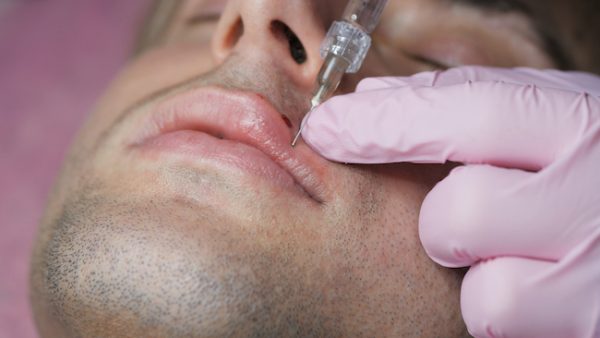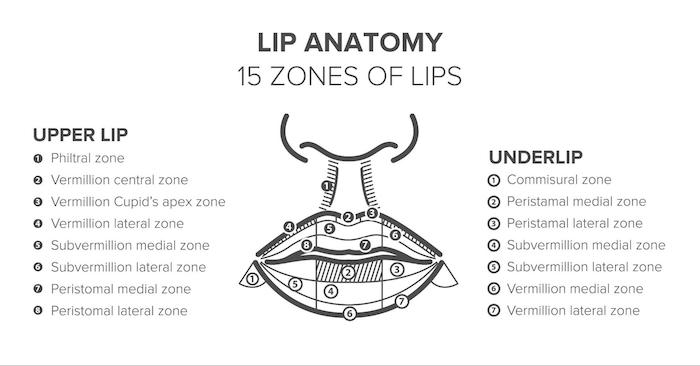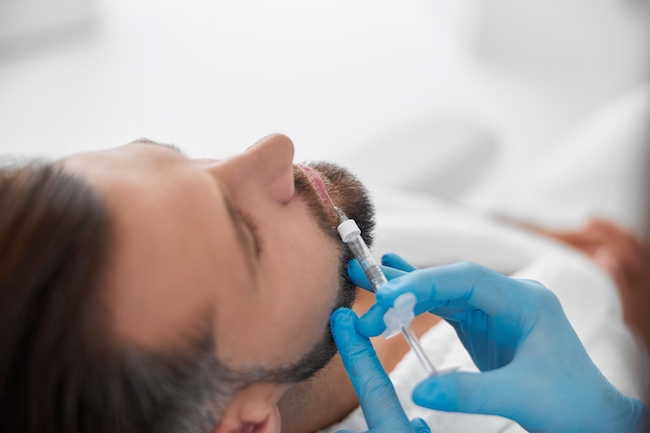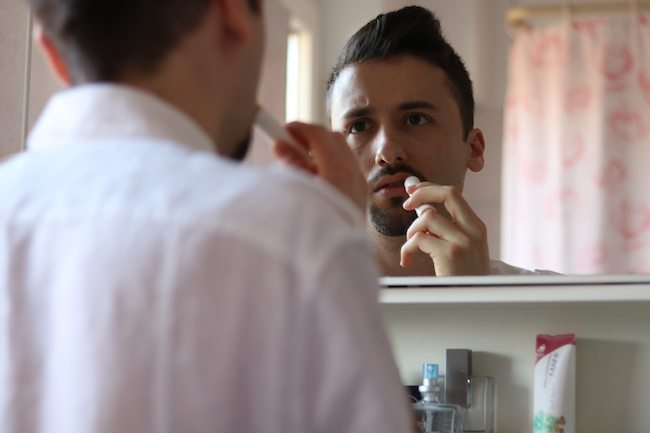
There are many reasons why men might decide to get lip fillers. They are often personal, but with the rise of social media, influencers and selfies, more and more men are searching for a perfect full lip to feel good about how they look. Thinner lips are genetic, and getting male lip fillers is often a good solution to improve the size and shape of male lips.
We all naturally lose collagen as we age, which can lead to thinner lips. If this is something that’s concerning you, a lip filler procedure might also help. Male lip fillers don’t stop the ageing process or tissue death, but they can boost your confidence.
In under an hour, injectable aesthetic treatments can roll back the clock by as much as ten years! And with little or no downtime and no scarring, dermal fillers for men are becoming more prevalent.
Maybe you have noticed your lips have become thinner, or you want your lips to look plumper. Choosing the right aesthetic practitioner is the first step to getting the best result and the lowest possible risk of complications. Another critical factor is the types of lip filler that are used. In this guide, we will tell you how to find the best aesthetic practitioner, the various types of lip fillers for men and the differences between them.
Men’s and women’s lips come in many shapes and sizes, but the anatomy of the lip is the same. This does not mean that injection techniques will be or should be the same for men as they are for women’s lip injections. As with any aesthetic injectable treatment, the technique needs to be tailored to address the individual anatomy and goals of the client.

Men typically seek subtle enhancement of lip volume rather than noticeable shaping and defining. The goal for most men who have lip fillers is to look as if nothing has ever been done. With that in mind, there should be no “standardised result”, and the entire face must be addressed holistically before any aesthetic treatment.
As you age, your lips become thinner and lose definition. Adding volume can enhance your lips and help make your overall facial appearance more youthful. The key is maintaining balance to achieve a natural result. If you have Botox or anti-wrinkle injectable treatments, don’t forget that your lip shape can also give you a more youthful appearance.

Dermal fillers come in varying consistencies and work in different ways. Two main types of FDA-approved fillers are used to augment lips. Let’s look at the pros and cons of each type of filler.
Radiesse is the most common brand of Calcium hydroxylapatite (CaHA) injectable dermal filler. Composed mainly of a naturally occurring substance found in bones and teeth, this gel-like filler works by stimulating the production of collagen. Although this filler can be injected into the lips, the semi-solid consistency makes it more suitable for deeper tissue injections, such as the laughter lines.
• Pros: Lasts 12 to 18 months.
• Cons: More likely to cause visible or painful lumps and cannot be dissolved.
Juvederm, Restylane and Perlane are three of the most used brands of Hyaluronic acid (HA) dermal fillers for lip injections. This soft gel-like filler is usually the preferred lip filler for men as it produces a more natural-looking result. Risks of lumps and complications with Hyaluronic acid (HA) dermal filler, when administered by an experienced aesthetic practitioner, are very low. Hyaluronic acid (HA) fillers can be dissolved if you are not happy with the result, and they are widely considered the safest dermal fillers to use for augmenting lips.
• Pros: Feels softer, has a lower risk of causing lumps and can be easily dissolved.
• Cons: Shorter lasting, with a lifespan between 6 and 12 months.
Fat injections or fat grafting is an option that uses your own tissue as the filler. Fat is removed from your abdomen area using a needle before being purified and transferred into the lips. These additional steps to harvest the fat mean the overall process takes longer, but female and male lip injections using transferred fat can last up to five years.
• Pros: Longer lasting than dermal filler
• Cons: A longer and more costly procedure.

Lip fillers are a minimally invasive procedure using filler injections. The most common type is hyaluronic acid (HA), a gel-like natural substance that naturally occurs in the body, which is then used as a lip injection to give natural lip enhancement and add volume. Lip fillers for men are the same as any other lip filler; the difference is the technique used to create a fuller, natural-looking masculine lip shape.
The procedure typically takes 20 to 30 minutes, and you can have lip filler on your upper lip, bottom lip or both to get the desired effect. The procedure will start with a consultation. A good aesthetic practitioner will want to understand the desired outcome and set realistic expectations.
Dermal fillers are minimally invasive, and while they can be applied to enhance lips and alter their shape slightly, they’re not a dramatic, permanent solution. If requested, the practitioner will use numbing cream before the lip augmentation. It only takes a few minutes to start working and lasts up to a few hours so you feel comfortable, making having lip injections a relatively pain-free experience.
Following this, the practitioner will take a fine needle to inject the hyaluronic acid into the lip in various places. The positioning of the injection sites determines the shape, structure and volume of the results. These points will depend on the effect you’re looking for, which is why choosing a reputable clinic for your dermal fillers is essential.
Fillers for men and women have minimal side effects. However, there are a few minor risks to the treatment. These are not all a given; most side effects are minor and will fade within a few days.
• Bruising: If you experience bruising, this should fade over time like any other bruising. The best way to avoid this is to choose your practitioner with care.
• Swelling: Swelling is not uncommon and will go down quite quickly. Use an ice pack to ease any initial discomfort of the swelling.
• Bleeding: Again, this is not uncommon and can depend on the patient. Keep the area clean, and this common side effect should go away after a short time.
• Pain at the injection site: This will probably go hand in hand with any bruising and might occur after the numbing cream has worn off. It’s nothing to worry about, but you should still try to keep the area clean to reduce the chance of infection.
• Infection: If you think your lips are infected, make sure you see a doctor. It’s likely that if caught early, it can be treated with antibiotics.
• Necrosis: This is a rare but severe form of cell injury that results in dead body tissue. Early signs include inflammation and discolouration.
• Lumps or asymmetry: It’s natural for filler to look a little uneven at first, and this can last for around one to two weeks. Speak to your practitioner about this as they should be able to advise when to be concerned.
The best way to minimise the side effects of lip fillers is to pick a reputable practitioner with great reviews. Highly qualified practitioners are trained in lip filler best practices, and the perfect injection technique is one of the most effective ways to prevent complications.
An experienced practitioner will guide you in choosing the lip fillers that suit your current lip size and shape. If you’re wondering how to pick the right practitioner and clinic for you, read on.

A lack of regulation around non-surgical aesthetic treatments has led to a boom in aesthetic courses and aesthetic practitioners working without a medical background.
Always check that your aesthetic practitioner is a qualified and registered medical professional. The current three healthcare professional regulatory bodies in the UK are the following:
• The General Dental Council (GDC)
• The Nursing and Midwifery Council (NMC)
• The General Medical Council (GMC).
Each regulator has a website where you can check if your aesthetic practitioner is registered. You can also find the process of making a complaint if you have any concerns about the care you have received.
Although serious complications are rare, if they do occur, they must be addressed correctly. Fundamentally, experienced registered aesthetic practitioners are aware that potential complications from fillers and Botox may happen, and they know how to treat them. However, an inexperienced practitioner might not recognise signs of serious complications or know how to treat them.
You should never feel rushed or under pressure during your consultation. All the risks and complications of your treatment should be explained, and you should have the opportunity to ask questions. Reputable aesthetic practitioners will also be happy to provide answers to questions at any point after your consultation.
Experience is one of the most important factors to consider when choosing an aesthetic practitioner. Aesthetic courses will not provide practitioners with the opportunity to treat complications, which is why experience is critical. Someone with experience is also more likely to have patient reviews and the ability to tailor their technique to the individual.
In recent years there has been an increasing emphasis on the role of hormones and wellbeing. Choosing an aesthetic practitioner who also treats conditions related to men’s health and can offer hormone tests and treatments will mean they likely have a more holistic approach to aesthetic treatments.
Research the average price of the treatment you are considering but don’t ever go by price alone! A professional aesthetic practitioner will normally have a clear price structure displayed on their website. Price will also depend on the clinic location. On average, the cost of Botox is around £150 to £200, and dermal fillers are between £200 and £350 for one area. This will also depend on the type of filler used.
Google reviews and social media accounts are great places to find reviews. But don’t just go by a star rating, as this can be misleading. Look at individual reviews and how the practitioner responds to a bad review. Do they offer to see the person again, or do they simply ignore it?
Before and after photos can give you an idea of how the aesthetic practitioner individualises their technique. If every photo of lip augmentation is the same, or you want a natural-looking result, but every photo shows full-volume lips, that’s a red flag. Remember, any before and after photos in an aesthetic practitioner’s portfolio will have been chosen by them, so you will only see the very best.
Lips play a big part in how we present ourselves, and if you want to enhance your lips to feel more confident about yourself, then make sure you choose a practitioner you trust.
It is not required by law to have any certification to administer dermal filler, but that doesn’t mean you shouldn’t be careful who you pick to do yours.
Here at Harley Medical MD Aesthetic Clinic in London, our goal is to provide effective, research-based, non-surgical medical aesthetic treatments focusing on natural-looking results. We are known for our patient care, built around a personal and considered 360-degree approach that our patients trust.
Our extensive treatment portfolio targets several skin concerns and men’s health, including testosterone replacement therapy, erectile dysfunction, premature ejaculation, anabolic-androgenic steroid use and human growth hormone (HGH) therapy. Patient safety is our number one priority, so we’ll never carry out treatment that isn’t right for you.
We use Hyaluronic acid (HA) dermal fillers for a natural-looking result when performing filler injections and lip fillers for men. At your initial consultation, we’ll discuss your goals and explain if the treatment you are considering will help you achieve the results you are looking for.
Here at Harley Street MD, we are registered with the General Medical Council (GMC), and our primary practitioner, Doctor Tan, has many years of surgical training and plenty of qualifications. Read more about Dr Tan here.

If you’re still unsure whether you’ll suit a fuller lip, try enhancing your lips naturally. You won’t get the same effect as dermal fillers, but this might give you some sense of what you might look like after lip augmentation.
How long do lip fillers last?
Dermal fillers are not permanent, and you can pick the type of filler used depending on how long the lip fillers last. There are other factors to consider as well. Your metabolism, the area injected and your age may all affect how quickly the hyaluronic acid breaks down.
Dermal fillers can last from around six months to up to a year. However, you might want to top up your dermal fillers after a few months, as the effect will lessen over time.
An alternative and increasingly popular option is newer-generation fillers that can last up to 18 months.
Are lip fillers reversible?
Hyaluronic acid fillers will break down over several months, so they’re great if you want to try out more volume without committing to anything permanent. However, if you’re unhappy with your new look, it is possible to dissolve the hyaluronic acid with an enzyme called hyaluronidase. This isn’t true of Botox, which we wouldn’t recommend using to increase lip size.
How much does lip filler for men cost?
This can depend on the procedure and the practitioner, but you should expect to pay anything between £250 and £1500. At Harley Street MD, our dermal filler procedure starts at £350.
The research and study references we used, in addition to our internal research, are all referenced here; most of them have an external link to the scientific publication. We work hard to bring you the most recent, impartial, factual and evidence-based information to help you make informed decisions.
• FDA-Approved Dermal Fillers. From: US Food and Drink Administration
• How Hyaluronic Acid is Used to Plump or Augment Lips. From: Healthline
• Complications of Hyaluronic Acid Fillers. From: EyeWiki by the American Academy of Ophthalmology
• Surgical and nonsurgical options to plump up your lips. From: American Society of Plastic Surgeons
• Lip Augmentation. From: Web MD
• Haneke E. Managing Complications of Fillers: Rare and Not-So-Rare. J Cutan Aesthet Surg. 2015 Oct-Dec;8(4):198-210. doi: 10.4103/0974-2077.172191. PMID: 26865784; PMCID: PMC4728901. From: NIH
• Government must regulate non-surgical cosmetic procedures within a year, say MPs. From: British Medical Journal
• Find a Healthcare Professional. From: Professional Standards Authority
• Hyaluronidase. From: National Institute for Health and Care Excellence







